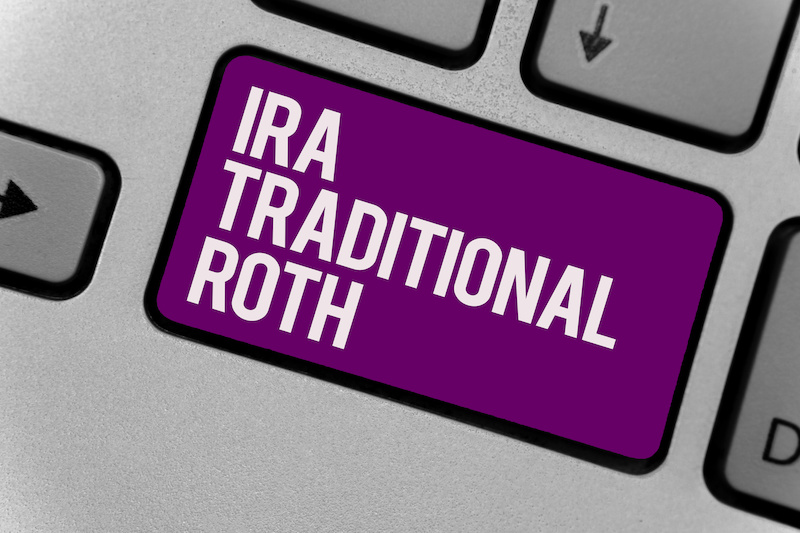How to Convert a Traditional IRA to a Roth IRA
by Gabriel Lewit

Everyone is always looking for ways to pay less in taxes, and a Roth IRA conversion is a popular strategy many retirees use to reduce their taxable income.
A Roth IRA rollover, or backdoor Roth as it is often called, is done when an individual moves money from their existing IRA or 401(k) into a Roth IRA. Many retirees use this because they anticipate that they will be in a higher tax bracket in the future and want to avoid the higher tax rate (check your 2023 tax bracket to know where you’ll be).
This is also an attractive option for investors whose earnings are too high to contribute directly to a Roth, as they can use this Roth conversion as a “backdoor” entry to gain tax-free income once they retire.
In this article, we will cover the following:
- How to convert to a Roth
- The tax benefits of converting from a traditional IRA to a Roth
- Why tax planning is crucial when planning out your distributions in retirement
- Understanding the five-year rule
Are your taxes going up in 2023? Be prepared for tax season and see what tax breaks and tax credits you are eligible for.
Rolling into a Roth IRA

A Roth IRA account allows individuals to contribute their after-tax dollars, making it an attractive option for savvy retirement planners. A Roth rollover or conversion takes the money from a traditional IRA or a 401(k) for those whose employers offer them.
Investors expecting to be taxed higher in future tax years compared to currently often utilize a Roth conversion to avoid paying taxes on future withdrawals. The process works like this:
- Decide on where you’d like to open your Roth IRA account.
- Withdraw funds from an eligible retirement account, either a traditional IRA or a 401(k). You can either receive a rollover check from the eligible account or contact the financial institution overseeing it and initiate an electronic transfer into your new Roth IRA account.
- Now you will need to pay taxes on any contributions and earnings, as you make Roth contributions with after-tax dollars.
- Be mindful that if you already have deductible contributions from your traditional IRA, you will owe taxes now. This can be a significant tax burden if you do not plan accordingly.
Be Aware of Taxes When Initiating a 401(k) Conversion
If you are converting employer-sponsored plans such as 401(k), be mindful of the rules and taxes that come with rolling it into a Roth. Some plans, like the thrift-savings plan for federal employees, allow you to access your funds while still working via an in-service distribution.
However, most plans will require you to reach age 59 1/2 before you can touch the money without penalty. When converting over to a Roth, it is crucial that the money is transferred directly to the financial institution and not to you so you can avoid the 20% tax penalty.
If, for whatever reason, you have the money transferred to you and you do not transfer it into your new Roth account within 60 days, then whatever money that is not rolled over will also be subject to an additional 10% early withdrawal penalty for those who are younger than 59 1/2. Understand and follow the rules and tax guidelines for transferring money from a 401(k) to avoid losing a substantial chunk of your retirement savings to taxes.
Use the Right Tax Strategy When Rolling Over Funds
If you were to roll over all of your money from your tax-deferred retirement accounts, it would very likely push you up into a higher tax bracket, resulting in a substantial tax bill. Luckily with a good tax planning strategy, there is no need for this to happen.
A much better strategy is executing the conversion over several years and never converting so much that your income is pushed up into the next tax bracket. For the years that your income is lower, you can convert more. A Roth rollover is a process that should be done over the course of several years and after thorough planning to avoid paying unnecessary taxes.
Understanding the Five-Year Rule
A Roth IRA conversion is a way to move money in your retirement accounts before the age of 59 1/2 without penalty. This process requires you to strategize your conversion to avoid jumping up tax brackets, but you must also plan your future withdrawals according to the five-year rule.
A Roth conversion requires you to wait five years before withdrawing the amount you converted. You will be hit with a 10% tax penalty if you do not. A five-year period is required for each conversion, so each conversion will create a “ladder” that you must abide by when planning your future withdrawals to avoid the tax penalty.
Because of this five-year rule, you should plan for your withdrawals in advance and start a Roth conversion at least five years before you plan on needing your funds.
The Tax Benefits of a Roth IRA
The tax benefits offered by a Roth retirement account are the prime reason many investors choose to use them when it comes time to distribute their income in retirement.

The earnings of a Roth grow tax-free, and any withdrawals made in retirement are also tax-free. Roth accounts are also not subject to RMDs for those concerned, allowing you not to use it if it is not needed. There are advantages before you hit 59 1/2 as well. You can take out your contributions at any time.
A Roth conversion is a fantastic way to avoid unnecessary taxes if you are expecting your future tax rate to be higher than it is now. Higher-income earners who may not be eligible to contribute to a Roth can still initiate a backdoor Roth conversion to reap the tax benefits in retirement.
For tax planning and retirement services, the trusted advisors at SGL Financial can help you strategize your taxes and income in retirement in a way that caters to your personal financial needs. Contact us today.
Read: Are you ready for retirement? Check out our 5-Piece Retirement Income Kit to make sure you’re set to retire in comfort

